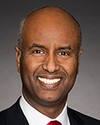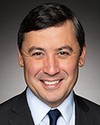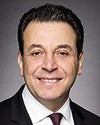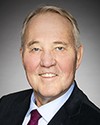Thank you, Mr. Chair.
Thank you for the invitation to appear today to brief you on recent Russian airspace violations over NATO territory. It's a pleasure to do so alongside my colleagues Stéphane Lessard, executive director, northern and central Europe relations division at Global Affairs Canada, and Mr. Ty Curran, deputy director general for international security policy at the Department of National Defence.
Mr. Curran and I had the honour of briefing your colleagues at the Standing Committee on National Defence last week, and we look forward to your questions.
Before starting, I would like to provide some context to the recent events and speak to Canada's contributions to Euro-Atlantic security and support to Ukraine.
Since September 10, we have seen an increase in airspace violations over NATO allied territory on the part of Russia. This has included multiple drones overflying Poland and Romania, as well as an airspace incursion by three Russian MiG-31 fighter jets over Estonia. We have also seen unauthorized incursions into airspace over the Copenhagen and Oslo airports by drones.
While it wasn't immediately clear who was behind the flyover of Denmark's Copenhagen airport, the Danish prime minister said that Russian involvement could not be ruled out. There were some further disruptions in Denmark overnight, and there has been no attribution yet except for the Danish defence minister saying that it was a “professional actor”.
Airspace violations on the part of Russia are not a new phenomenon. They have been a regular occurrence since Russia began its illegal invasion of Ukraine but accelerated in intensity and scope in 2025, including the use of drones and fighter jets.
In response to the most recent incursions, NATO and the affected allies showed determination and resolve and demonstrated unparalleled allied interoperability. The recent interception of Russian drones over Poland by allied aircraft, for example, included a coordinated response involving Dutch and Polish fighter jets, a NATO early warning aircraft, an Italian air-to-air refueller and German ground-based interceptors. Similar allied coordination happens in most instances.
Both Poland and Estonia invoked article 4 of the Washington treaty following the incidents. For the benefit of the committee, I would like to specify that article 4 of the Washington treaty states that allies “will consult together whenever, in the opinion of any of them, the territorial integrity, political independence or security of any of the Parties is threatened.” This is intended as a strong political signal to adversaries that a particular ally or allies feel threatened and may request assistance from other allies. This is not the same as article 5, the collective defence clause of the treaty, where an attack on one ally is considered an attack against all.
Following the September 23 article 4 consultations this week, the North Atlantic Council issued a statement this week condemning Russia's reckless actions, which are escalatory, risk miscalculation and endanger lives. A North Atlantic Council statement means that it was agreed by all 32 allies to send such a message.
In the statement, allies reaffirmed their unshakeable shared commitment to defending allied territory, and they confirmed that General Grynkewich, NATO's supreme allied commander, or SACEUR, has the tools and authorities he needs to ensure NATO's defence. Eastern Sentry, which was launched following the incursion into Polish airspace, adds further strength and flexibility to NATO's posture along the eastern flank.
Deliberate or not, Russia's recent reckless actions are part of a dangerous pattern of cyber and hybrid activities by Russia to test and probe allied responses. I can show sabotage, disturbances to GPS, weaponization of migrants, sabotage of critical underwater infrastructure and disinformation campaigns across Europe as examples.
With all of this going on, you might ask this: How is Canada protecting its allies?
NATO remains a cornerstone of Canada's defence. We are contributing substantially to the alliance's core tasks and missions, including along the eastern flank. Canada's troop contributions to NATO's multinational brigade in Latvia, which we lead, has more than doubled in size since Russia's invasion of Ukraine and is growing stronger. This is a tangible demonstration of Canada's commitment to Baltic security, one which Prime Minister Carney renewed for another three years just recently.
Canada is also the third-largest contributor to NATO's mission providing security assistance and training to Ukraine, also known as NSATU.
Under our G7 presidency and in consultation with our partners, Canada is continuing to pressure Russia to end its war in Ukraine.
Last summer, at the G7 summit in Kananaskis, Prime Minister Carney announced the largest round of trade and maritime sanctions imposed by Canada since the invasion of Ukraine.
In Charlevoix, in March 2025, the G7 foreign ministers also adopted the G7 Declaration on Maritime Security and Prosperity, a Canadian initiative that reaffirms the G7's steadfast commitment to helping maintain a free, open and secure maritime domain based on respect for the rule of law that strengthens international security, fosters economic prosperity and ensures environmental sustainability.
As part of this initiative, Canada established a shadow fleet task force with participating G7 members, in partnership with the eight Nordic and Baltic countries.
Canada is continuing to work with its close partners to coordinate additional measures against the Russian regime in order to increase the economic cost of Russia's war of aggression.
Recently, on September 22, 2025, Minister Anand met with her G7 counterparts on the sidelines of the high‑level week of the United Nations General Assembly.
In a joint statement by the G7 this week, foreign ministers expressed concern about Russia's recent violations of the airspace of Estonia, Poland and Romania. These were unacceptable violations that threaten international security.
The ministers reaffirmed their commitment to work together to achieve lasting peace and build a strong, independent, sovereign and prosperous Ukraine by continuing to coordinate their efforts with the United States to provide Ukraine with robust and credible security guarantees.
The ministers also discussed the need to impose new economic sanctions against Russia, including taking measures against third countries that facilitate its activities.
In conclusion, I can say that NATO's response to Russia's actions remains strong.
NATO has taken vigorous measures to strengthen our deterrence and defence posture in response to Russia's persistent attempts to test the alliance's defences.
Canada remains committed to contributing to the security of its allies, particularly on NATO's eastern flank, and to supporting Ukraine—whose security contributes to our own—in its right to defend itself against Russia's ongoing aggression.
We'll keep working with our allies to rebuild Ukraine and strengthen its long‑term resilience.
We're ready to answer your questions.
Thank you.










